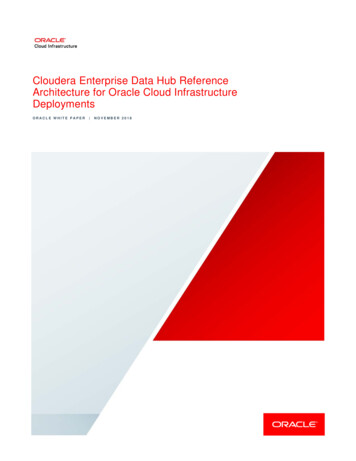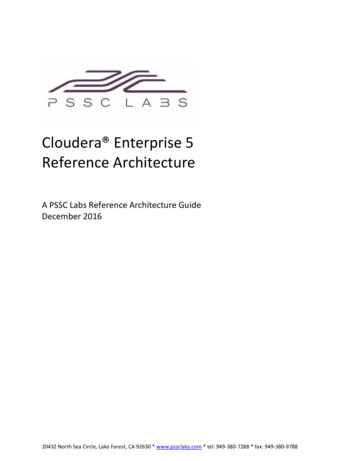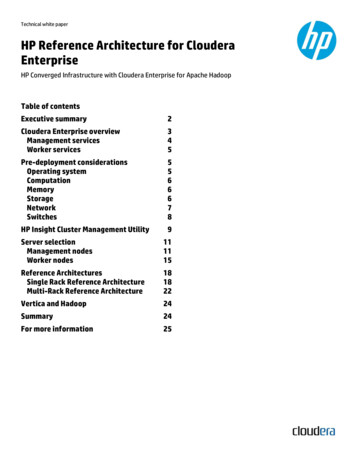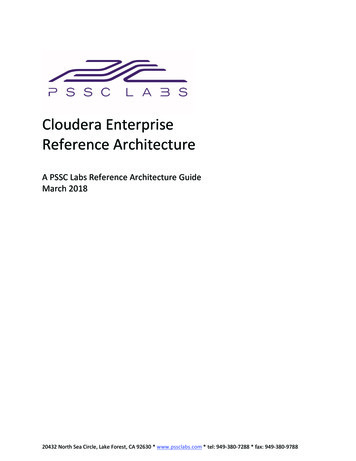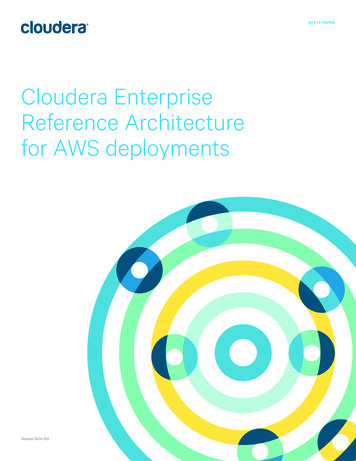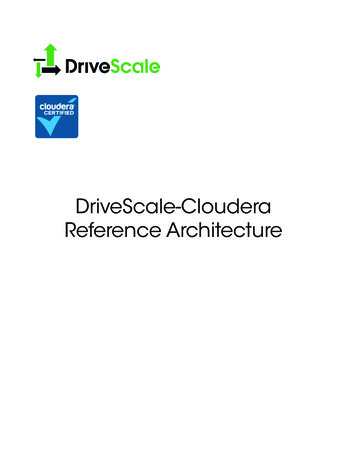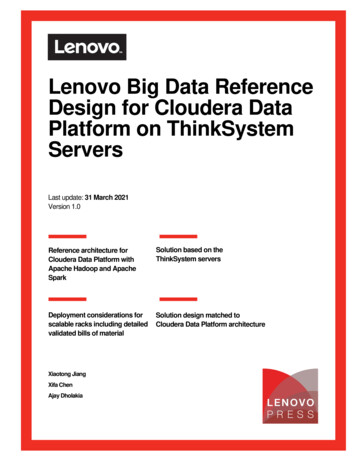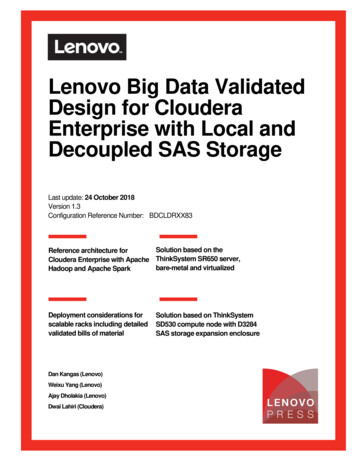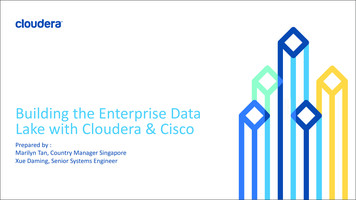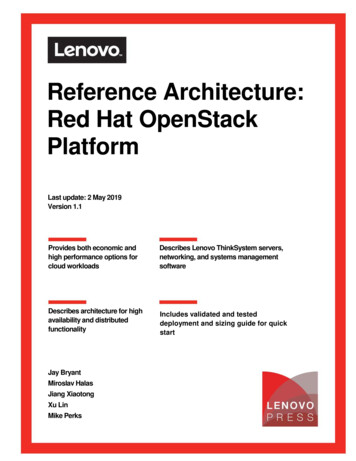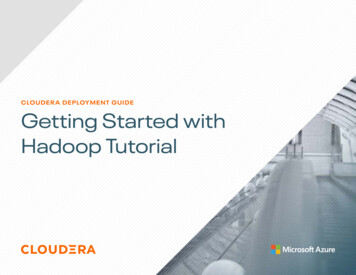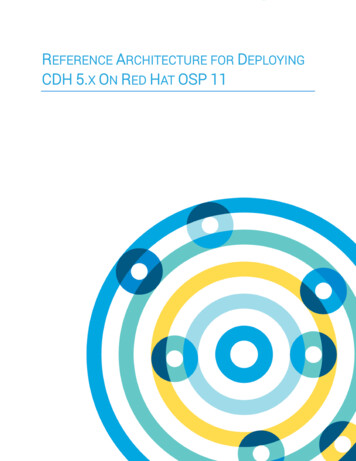
Transcription
REFERENCE ARCHITECTURE FOR DEPLOYINGCDH 5.X ON RED HAT OSP 11Cloudera Enterprise Reference Architecture for Red Hat OpenStack Platform 11 1
Important Notice 2010-2017 Cloudera, Inc. All rights reserved.Cloudera, the Cloudera logo, Cloudera Impala, Impala, and any other product or service names or sloganscontained in this document, except as otherwise disclaimed, are trademarks of Cloudera and its suppliers orlicensors, and may not be copied, imitated or used, in whole or in part, without the prior written permission ofCloudera or the applicable trademark holder.Hadoop and the Hadoop elephant logo are trademarks of the Apache Software Foundation. All other trademarks,registered trademarks, product names and company names or logos mentioned in this document are the propertyof their respective owners to any products, services, processes or other information, by trade name, trademark,manufacturer, supplier or otherwise does not constitute or imply endorsement, sponsorship or recommendationthereof by us.Complying with all applicable copyright laws is the responsibility of the user. Without limiting the rights undercopyright, no part of this document may be reproduced, stored in or introduced into a retrieval system, ortransmitted in any form or by any means (electronic, mechanical, photocopying, recording, or otherwise), or forany purpose, without the express written permission of Cloudera.Cloudera may have patents, patent applications, trademarks, copyrights, or other intellectual property rightscovering subject matter in this document. Except as expressly provided in any written license agreement fromCloudera, the furnishing of this document does not give you any license to these patents, trademarks copyrights,or other intellectual property.The information in this document is subject to change without notice. Cloudera shall not be liable for any damagesresulting from technical errors or omissions which may be present in this document, or from use of this document.Cloudera, Inc.1001 Page Mill Road, Building 2Palo Alto, CA 94304-1008info@cloudera.comUS: 1-888-789-1488Intl: 1-650-843-0595www.cloudera.comRelease InformationDate: 7/10/17Version: 5.12Cloudera Enterprise Reference Architecture for Red Hat OpenStack Platform 11 2
Executive Summary . 4Business Objectives . 5Cloudera Enterprise. 5About Red Hat . 6About Red Hat OpenStack Platform . 6Audience and scope . 7Reference Architecture . 8Component design . 8Component Table . 9Network . 9Compute (Nova) . 11Storage . 15Cloudera Software stack. 26Logical Component Layout Tables . 27Instance-type Table . 29Enabling Hadoop Virtualization Extensions (HVE). 30References . 35Glossary of Terms . 35Cloudera Enterprise Reference Architecture for Red Hat OpenStack Platform 11 3
Executive SummaryThis document provides a reference architecture for deploying Cloudera Enterprise includingCDH on Red Hat’s OSP 11. Much like the Hadoop platform, OpenStack is comprised of anumber of related projects to control pools of storage, processing, and networking resourceswithin a data center, and to build a multi-datacenter private cloud infrastructure. The followingOpenStack projects are in scope for this release of the reference architecture: Compute (Nova): on-demand computing resources from a large network of virtualmachinesStorage Service (Cinder): storage management and provisioning for Cloudera Instanceswhile maintaining data localityNetworking (Neutron): flexible models for managing networks and IP addresses(includes Open vSwitch)Image service (Glance): discovery, registration, and delivery for disk and virtual machineimagesIdentity Management service (Keystone): Manage identity and authorizations for varioussystem users, projects and end-users who will use the OpenStack self-serviceinfrastructureThis release of the reference architecture is for deploying Cloudera’s Distribution of ApacheHadoop (CDH) 5.11 on Red Hat OSP 11. This reference architecture articulates a specificdesign pattern which is recommended to be administrator-driven as opposed to end-user selfservice based. The RA will also be applicable for all 5.x releases of CDH subsequent to C 5.11.Other OpenStack projects, such as telemetry and alerting (Ceilometer), monitoring (Horizon),elastic mapreduce (Sahara), Orchestration (Heat), and bare metal (Ironic), are considered out ofscope for this release of the reference architecture.Also out of scope are Object Storage services (Swift and Ceph) and the Software Defineddistributed storage platform (Ceph).Future editions may include more information on these OpenStack projects.Cloudera Enterprise Reference Architecture for Red Hat OpenStack Platform 11 4
Business ObjectivesThe objective of this Reference architecture is to provide safe and reliable design patterns thatcustomers can use to leverage OpenStack to deploy Cloudera EDH IaaS clusters in privatecloud environments.Cloudera EnterpriseCloudera is an active contributor to the Apache Hadoop project and provides an enterpriseready, 100% open-source distribution that includes Hadoop and related projects. The Clouderadistribution bundles the innovative work of a global open-source community, including criticalbug fixes and important new features from the public development repository, and applies it to astable version of the source code. In short, Cloudera integrates the most popular projectsrelated to Hadoop into a single package that is rigorously tested to ensure reliability duringproduction.Cloudera Enterprise is a revolutionary data-management platform designed specifically toaddress the opportunities and challenges of big data. The Cloudera subscription offeringenables data-driven enterprises to run Apache Hadoop production environments cost-effectivelywith repeatable success. Cloudera Enterprise combines Hadoop with other open-sourceprojects to create a single, massively scalable system in which you can unite storage with anarray of powerful processing and analytic frameworks—the Enterprise Data Hub. By unitingflexible storage and processing under a single management framework and set of systemresources, Cloudera delivers the versatility and agility required for modern data management.You can ingest, store, process, explore, and analyze data of any type or quantity withoutmigrating it between multiple specialized systems.Cloudera Enterprise makes it easy to run open-source Hadoop in production:Accelerate Time-to-Value Speed up your applications with HDFS caching Innovate faster with pre-built and custom analytic functions for Cloudera ImpalaMaximize Efficiency Enable multi-tenant environments with advanced resource management (ClouderaManager YARN) Centrally deploy and manage third-party applications with Cloudera ManagerSimplify Data Management Data discovery and data lineage with Cloudera Navigator Protect data with HDFS and HBase snapshots Easily migrate data with NFSv3 supportSee Cloudera Enterprise for more detailed information.Cloudera Enterprise can be deployed in a Red Hat OpenStack Platform based infrastructureusing the reference architecture described in this document.Cloudera Enterprise Reference Architecture for Red Hat OpenStack Platform 11 5
About Red HatRed Hat is the world’s leading provider of open source software solutions, using a communitypowered approach to reliable and high-performing cloud, Linux, middleware, storage, andvirtualization technologies. Red Hat also offers award-winning support, training, and consultingservices. As a connective hub in a global network of enterprises, partners, and open sourcecommunities, Red Hat helps create relevant, innovative technologies that liberate resources forgrowth and prepare customers for the future of IT.About Red Hat OpenStack PlatformRed Hat OpenStack Platform allows customers to deploy and scale a secure and reliableprivate or public OpenStack cloud. By choosing Red Hat OpenStack Platform, companies canconcentrate on delivering their cloud applications and benefit from innovation in the OpenStackcommunity, while Red Hat maintains a stable OpenStack and Linux platform for productiondeployment.Red Hat OpenStack Platform is based on OpenStack community releases, co-engineered withRed Hat Enterprise Linux 7. It draws on the upstream OpenStack technology and includesenhanced capabilities for a more reliable and dependable cloud platform, including: Red Hat OpenStack Platform director, which provides installation, day-to-daymanagement and orchestration, and automated health-check tools, to ensure ease ofdeployment, long-term stability, and live system upgrades for both core OpenStackservices, as well as the director itself.High availability for traditional business-critical applications via integrated, automatedmonitoring and failover services.Stronger network security and greater network flexibility with OpenStack Neutronmodular layer 2 (ML2), OpenvSwitch (OVS) port security, and IPv6 support.Integrated scale-out storage with automated installation and setup of Red Hat CephStorage.A large OpenStack ecosystem, which offers broad support and compatibility, with morethan 350 certified partners for OpenStack compute, storage, networking, andindependent software vendor (ISV) applications and services.Cloudera Enterprise Reference Architecture for Red Hat OpenStack Platform 11 6
Audience and scopeThis reference architecture is aimed at Datacenter, Cloud, and Hadoop architects who will bedeploying Cloudera’s Hadoop stack on private OpenStack cloud infrastructure.This release of the reference architecture is for deploying Cloudera’s Distribution of ApacheHadoop (CDH) 5.11 on Red Hat OSP 11. This reference architecture articulates a specificdesign pattern which is recommended to be administrator-driven as opposed to end-user selfservice based. The RA will also be applicable for all 5.x releases of CDH subsequent to C 5.11.Other OpenStack projects, such as telemetry and alerting (Ceilometer), monitoring (Horizon),elastic mapreduce (Sahara), Orchestration (Heat), and bare metal (Ironic), are considered out ofscope for this release of the reference architecture.Also out of scope are Object Storage services (Swift and Ceph) and the Software Defineddistributed storage platform (Ceph).Future editions may include more information on these OpenStack projects.Cloudera Enterprise Reference Architecture for Red Hat OpenStack Platform 11 7
Reference ArchitectureComponent designThe following diagram illustrates the various components of the OpenStack deployment. Not allthe components shown in this high level diagram are covered in this reference architecturedocument. Please refer to the Audience and Scope section - it highlights which components areconsidered in scope and which are considered out of scope for this revision.High level block diagram 1Cloudera Enterprise Reference Architecture for Red Hat OpenStack Platform 11 8
Component nent Details 3 ComputeNodeMinimum8, maxDependson usecase. 2-sockets with 6-10 coresper socket128GB RAM2 x 10GbE NICso 1 x 10GbE forCompute/Tenantnetworko 1x 10GbE for Mgmtnetwork6 x 2TB internal HDDso 4 x drives in RAID10 configuration forvarious Databaseso 2 x drives in RAID-1for OS bits2-sockets with 6-10 coresper socketAt least 256GB RAM2 x 10GbE NICso 1 x 10GbE Tenantnetwork interfaceso 1 x 10GbEManagementnetwork interface12-24 2TB internal HDDso 2 x HDDs in RAID-1for OS bitso All other spindles inJBOD mode, to bepresented as CinderLVM backends.Details provided inDescriptionSet up 3 controller nodes inHA configuration. This willensure that the various keycomponents of theOpenStack deployment willcontinue to run in case of ahardware failureA minimum of 3 Masterand 5 worker nodes (CDH)are needed to ensure thatwhen HDFS blocks areplaced within VMs runningon these nodes, we havephysical disparity to matchthe 3x replication factor ofHDFS. We will use HVE toensure that duplicatecopies of any HDFS blockare not placed on the samecompute node. But thereneed to be at least thephysical availability of 8compute nodes.Storageconfigurationsection of thisdocument.NetworkThis section covers the network topology used in development of this reference architecture, aswell as a brief summary of options available in the OpenStack ecosystem in general. A genericguideline for networking would be to advise the customers to pick a model that yields highestnetwork throughput, or at least sufficient network throughput to match the theoretical throughputcapabilities of the disks being presented to the VMs on each physical node.Cloudera Enterprise Reference Architecture for Red Hat OpenStack Platform 11 9
Network topology diagram 2a. Controller and compute nodes have 2 x 10GbE NICs each - one will provide the tenantnetwork, the other is the management network which is used for OS provisioning of the physicalinfrastructure, as well as provide data path for other OpenStack management traffic.b. There are two general flavors of network topology that can be used in an OpenStack basedprivate cloud.1. Provider Networks -- Provider Networks are essentially physical networks(with physical routers) and are managed by the OpenStackadministrators. End-users cannot manage and make changes to thesenetworks. They are the simplest and also the most performant. Theyentail connecting directly to the physical network infrastructure withminimal SDN (Software Defined Networking) functionality being used.2. Self-Service networks -- These are networks that can be created andmanaged by the OpenStack end-users. The underlying physicalinfrastructure can be provider networks, but there would a virtualizedoverlay using VXLAN or GRE tunneling. These would typically be privateCloudera Enterprise Reference Architecture for Red Hat OpenStack Platform 11 10
networks which will be routed through a software router hosted on anetwork controller node.NOTE: In our labs, we have used a provider-network based deployment, which provides betternetwork performance for Hadoop workloads, wherein each compute node is able todirectly access the physical network infrastructure. This model is however limiting interms of flexibility in scenarios where self-service capabilities are needed.For best network performance, consider using SR-IOV. This will allow the VMs to directlyaccess previously defined virtual functions created on physical NICs. This option isfurther limiting in terms of flexibility, and the NIC hardware is subject to supportability onRed Hat OSP.For a more detailed understanding of the various networking options available in RedHat OSP 11, refer to the Networking Guide.Compute (Nova)The compute nodes’ design considerations are as follows a. The hypervisor (KVM/QEMU)b. The instance storage location - Let there be sufficient storage capacity in /var/lib/nova/ tohouse the ephemeral root disksc. other considerations if applicable - such as appropriate drivers for network and storage, etc foroptimal performance.Cloudera Enterprise Reference Architecture for Red Hat OpenStack Platform 11 11
Logical instance diagram 3Over Commitment RatioOpenStack’s default over-subscription ratio (OSR) of CPU is 16:1 and Memory is 1.5:1. ForHadoop workloads we recommend setting the CPU OSR to 1:1 and Memory OSR to 1:1. Do notover-commit either of the resources. Hadoop workloads are very CPU and memory heavy,besides being IO and Network intensive; they will push the boundaries on all thesubcomponents of your infrastructure.Set the following in /etc/nova/nova.conf on all nodes running Nova-compute -cpu allocation ratio 1ram allocation ratio 1Cloudera Enterprise Reference Architecture for Red Hat OpenStack Platform 11 12
Instance Types/FlavorsRed Hat OSP 11 does not have instance flavors defined out of the box. Therefore, considercrafting some custom ones that make sense for Hadoop workloads.We have provided some guidance towards reasonable flavors. These are dependent on theworkloads being run on Cloudera EDH.Instance Flavors TableNameRAM (MB) Disk (GB) Ephemeral (GB) VCPUscdh-tiny102410101cdh-quartersize 80100036The number of vCPUs to allocate will depend on the number of cores per Socket.NOTE: The flavor configurations are provided here as guidelines. Depending on the use case,the customer should adjust the size of CPUs and Memory. Typically it is recommendedto make the instances larger in size and along CPU socket boundaries. Memory sizeswill be predicated by the number of applications and types of services that will berunning in the cluster.The general guidance for CPU allocation is to maintain 1:1 HT core to vCPU ratio.Similarly for RAM, guidance is to maintain 1:1 Physical to Virtual Memory allocationratio. However, 1-2 cores and about 32GB of RAM should be left reserved for thehypervisor OS.Customers are advised to work with their Cloudera Account teams to determine the bestinstance flavors applicable to their environments, based on their existing or proposedworkloads.o It is a good idea to keep minimum supportable configurations in mind whiledefining these flavors. For instance, Cloudera’s MPP component - Impala has aminimum requirement for 128GB, and ideally at least 256GB of RAM.Cloudera Enterprise Reference Architecture for Red Hat OpenStack Platform 11 13
The root disk should be at least 100GB, preferably 200GB, such that we have sufficientlogging space in the “/var” mountpoint/directory.War
Cloudera Enterprise Reference Architecture for Red Hat OpenStack Platform 11 10 Network topology diagram 2 a.Controller and compute nodes have 2 x 10GbE NICs each - one will provide the tenant network, the other is the management ne
